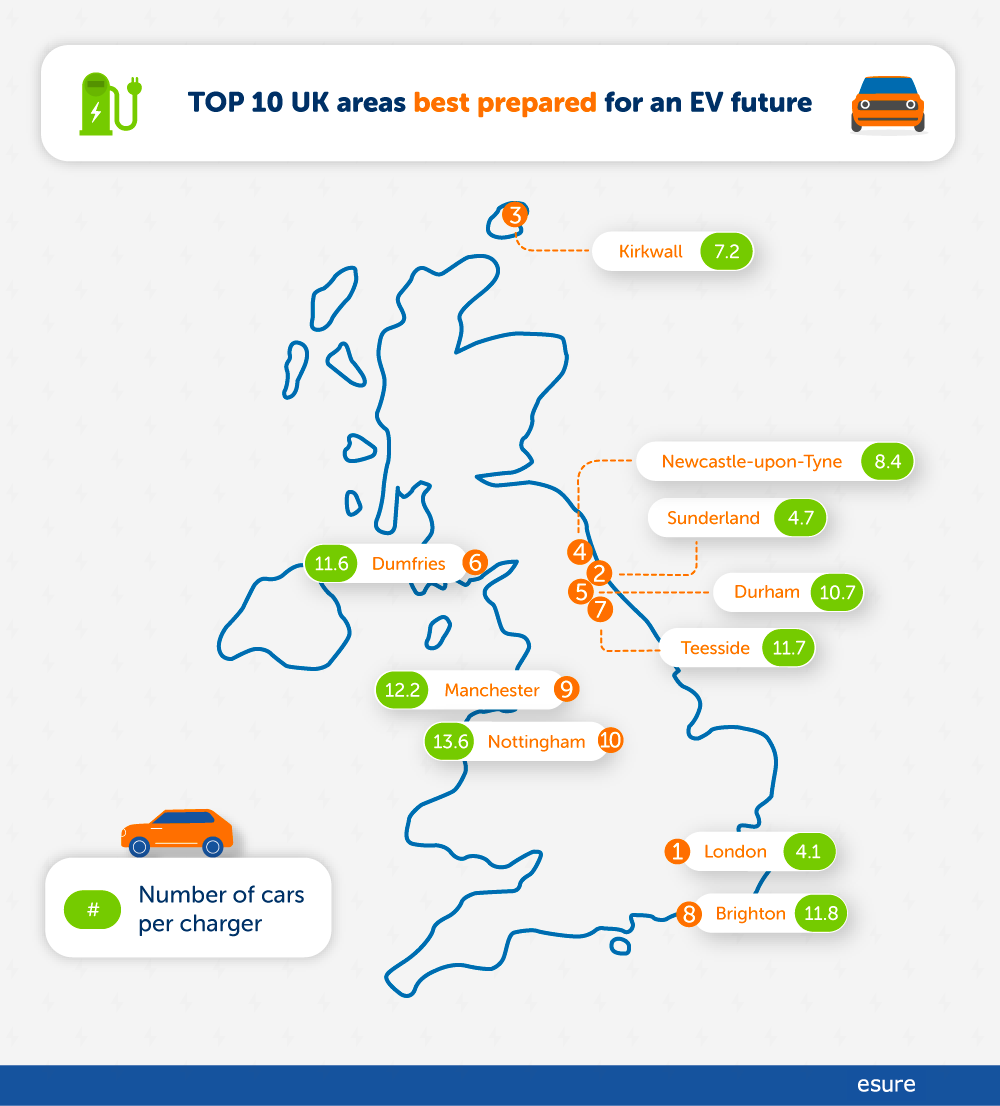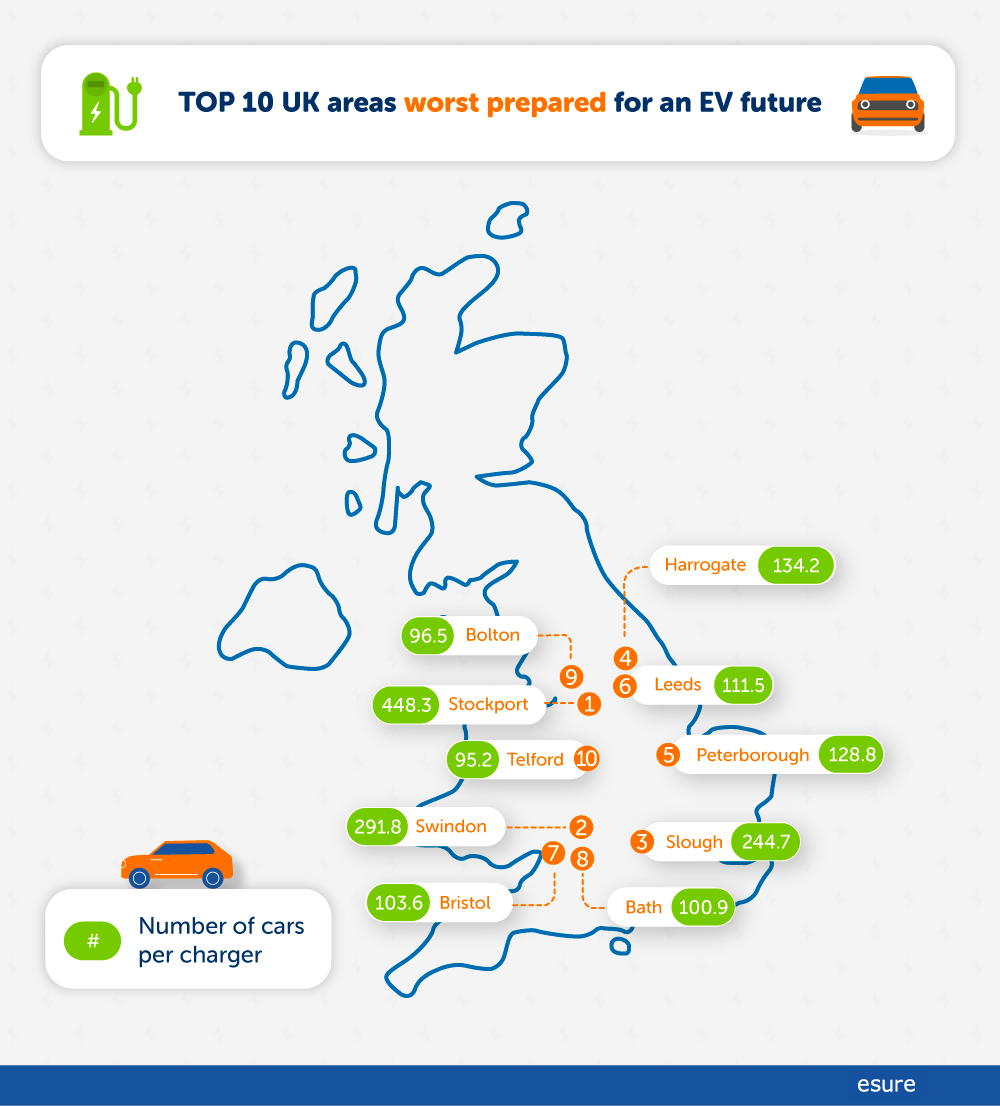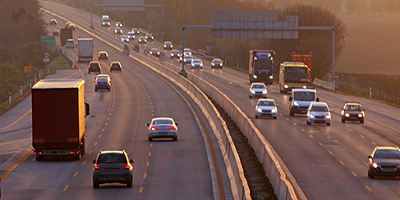The UK areas that are best and worst prepared for the Electric Vehicle (EV) revolution

Over the last few years, there’s been a noticeable shift on the roads in terms of the types of cars we’re seeing; you’ll have likely noticed a rise in electric vehicles, driven by new government regulations set to hit the UK in 2030 banning the sale of new petrol and diesel cars.
But with the deadline less than a decade away, which UK towns, cities, and regions are best- and worst-prepared?
In this article, using data provided by the DVLA and U.K. Government, we’ve analysed the number of charging points per electric vehicle currently installed around the country, to pinpoint the areas that are ready for the electric revolution – and those that need to speed up their offering.
The best prepared places for the rise in electric vehicles
Analysing areas by how many charging points they have per electric or hybrid car, we can reveal that London is the best-equipped UK city; incredibly, with over 7,500 charging points installed throughout the capital, there’s a charger for every 4.1 EVs – making London twice as prepared as Brighton (11.8), ten times better than Hemel Hempstead (39.4) and 20 times better than Guildford (89.0).
Heading north, Sunderland places second with a charger for every 4.7 electric or hybrid cars, making Wearside almost twice as prepared as nearby Newcastle-upon-Tyne (8.4), and in a far better position than North East neighbours Durham (10.7) and Teesside (11.7).
Meanwhile, across the border, despite being home to the fewest EVs in the country, Kirkwall is the best-prepared Scottish area for electric vehicles – with 25 chargers between 180 cars, that’s one for every 7.2 electric or hybrid motor. Not far behind, however, Dumfries has one for every 11.6.
Staying in Scotland, Motherwell (20.7) and Dundee (25.0) are better prepared than capital city Edinburgh (33.5), where, incidentally, it’s twice as easy as Glasgow (66.2) to charge your electric vehicle.

Volume of electric vehicles and hybrid vehicles registered in 2021 gathered via FOI request from the DVLA, data correct as of 21/02/2022. Chargepoint data was gathered via GOV and API call, data correct as of 28/01/2022. To determine the number of cars per charger, the volume of EV and hybrid ownership per area was divided by the number of chargers available in each area.
The worst prepared places for the rise in electric vehicles
With 448.3 electric and hybrid vehicles having to share each charger, Stockport is the worst-prepared place for the introduction of EV legislation - 36 times worse off than nearby Manchester (12.2). Also trailing, we have Swindon and Slough, where you’ll find just one charging station for every 291.8 and 244.7 cars, respectively. This can quickly lead to range anxiety with drivers beginning to worry about whether they’ll have enough charge to reach their destination, if they haven’t already charged at home.
Meanwhile, North Yorkshire spa town Harrogate places fourth among the least ready regions. With just one charging point for every 134.2 electric or hybrid cars, it’s 3.5 times harder to find a charger here than in historic county capital York (38.2). West Yorkshire city Leeds isn’t far behind though, with over 111 cars per charger, while East Yorkshire’s Hull (64.3) and South Yorkshire’s Sheffield (55.4) offer roughly twice the charging capacity.
Peterborough also places among the least prepared areas, with an average of 128.8 electric or hybrid cars jostling for each charging port, joined by Bristol (103.6), Bath (100.9), and Bolton (96.5). Finally, rounding out the ten worst-equipped regions, we have Shropshire town Telford (95.2).
Heading northwards, Scotland’s worst-prepared place is Falkirk, with a solitary charging port for every 90.3 EVs - followed by major hub Glasgow (66.2).

Volume of electric vehicles and hybrid vehicles registered in 2021 gathered via FOI request from the DVLA, data correct as of 21/02/2022. Chargepoint data was gathered via GOV and API call, data correct as of 28/01/2022. To determine the number of cars per charger, the volume of EV and hybrid ownership per area was divided by the number of chargers available in each area.
With EVs becoming increasingly commonplace on our roads, it’ll be interesting to see which areas continue to install more recharging points in the coming years. If you drive an electric or hybrid vehicle, get a quote today to see how much you could be paying for your car insurance, or check out our blog for all the latest insights from our team.
Methodology
To determine the best and worst prepared towns and cities for drivers of EVs, we collected DVLA electric and hybrid vehicle ownership data for each area of the UK, as well as government charge point information. We then divided the number of EV owners per area by the number of local chargers available, to reveal the most and least ready regions.
References:
Government U.K.. (2020). Government takes historic step towards net-zero with end of sale of new petrol and diesel cars by 2030. Available: https://www.gov.uk/government/news/government-takes-historic-step-towards-net-zero-with-end-of-sale-of-new-petrol-and-diesel-cars-by-2030. Last accessed 10/03/22.
FOI Request from DVLA – data can be found here: EV Readiness Cars per chargers DVLA data
You might also be interested in
Understanding your car cover and when it applies
Check out our video for top car cover tips.
FCA changes to insurance and how they may affect your premium
The Financial Conduct Authority (FCA) – an insurance industry regulator – recently introduced new regulation to insurance pricing to take effect on 1 January 2022.

